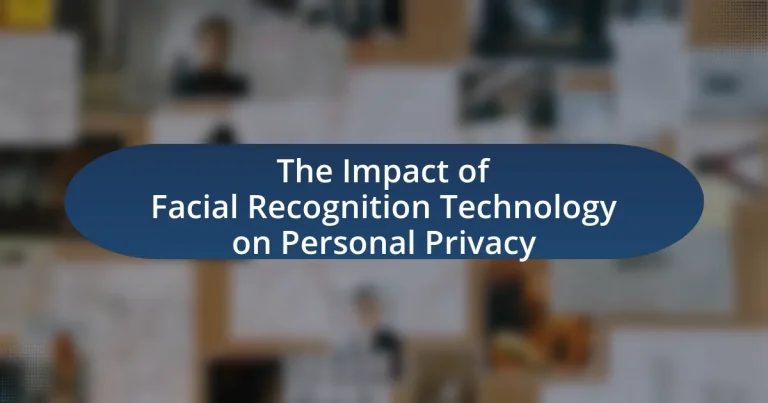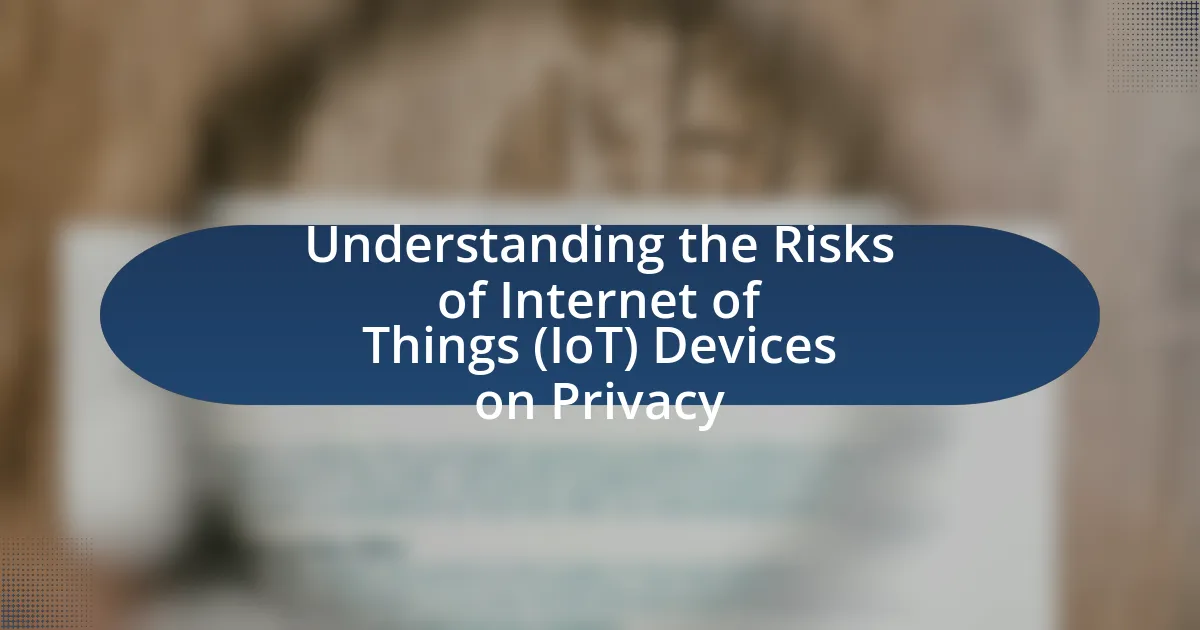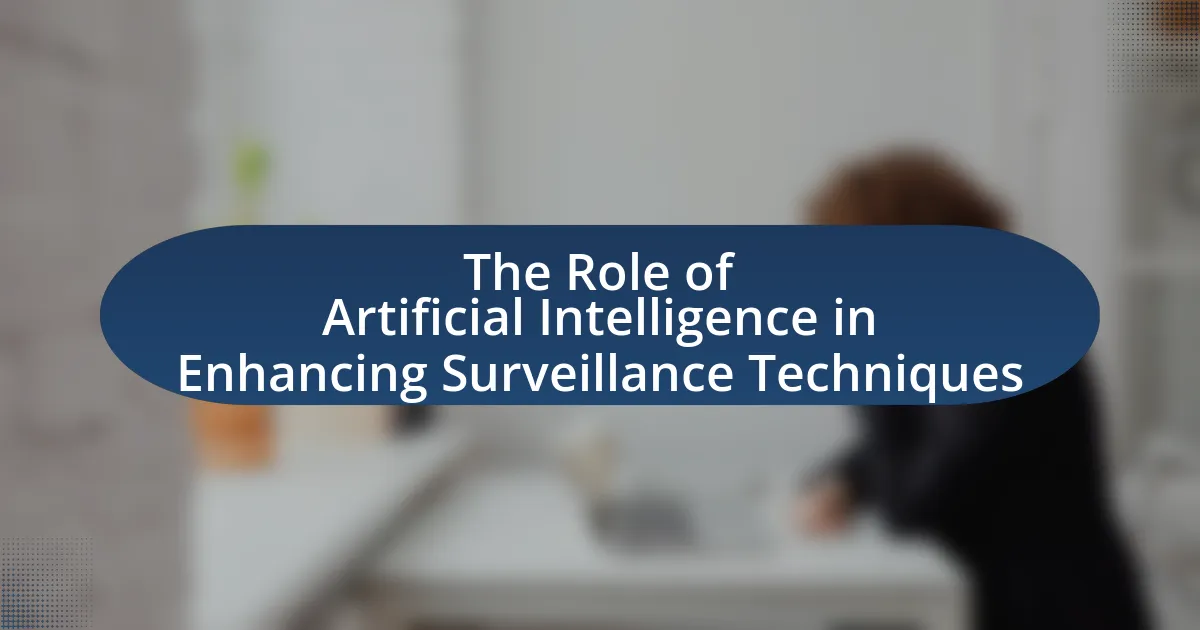Facial recognition technology significantly impacts personal privacy by enabling extensive surveillance and data collection without individuals’ consent. This article examines how the technology functions, its key components, and the algorithms that process facial data, while also highlighting its potential benefits, such as enhanced security and improved customer service. However, it raises critical privacy concerns, including unauthorized data collection, risks of misidentification, and the implications of mass surveillance on individual rights. The article further explores existing legal frameworks, societal attitudes towards privacy, and future trends in facial recognition technology, emphasizing the need for regulatory measures to protect personal privacy in an increasingly monitored world.

What is the Impact of Facial Recognition Technology on Personal Privacy?
Facial recognition technology significantly impacts personal privacy by enabling widespread surveillance and data collection without individuals’ consent. This technology allows governments and corporations to track individuals’ movements and behaviors in public spaces, raising concerns about the erosion of anonymity. Studies indicate that 70% of Americans express discomfort with facial recognition systems being used by law enforcement, highlighting public apprehension regarding privacy violations. Furthermore, incidents of misidentification can lead to wrongful accusations, exacerbating the risks associated with its use. The potential for abuse in monitoring and profiling individuals underscores the urgent need for regulatory frameworks to protect personal privacy in the face of advancing facial recognition technology.
How does facial recognition technology function?
Facial recognition technology functions by analyzing and identifying human faces through a series of steps involving image capture, feature extraction, and matching. Initially, a camera captures an image of a face, which is then processed to detect facial landmarks such as the distance between the eyes, the shape of the jawline, and the contour of the lips. These features are converted into a unique mathematical representation, often referred to as a faceprint. This faceprint is then compared against a database of known faces using algorithms that assess similarities and differences. The accuracy of this technology is supported by studies indicating that modern facial recognition systems can achieve over 99% accuracy under optimal conditions, as reported by the National Institute of Standards and Technology in their 2019 report on facial recognition accuracy.
What are the key components of facial recognition systems?
The key components of facial recognition systems include image capture, feature extraction, and matching algorithms. Image capture involves using cameras or sensors to obtain facial images, which are then processed to identify key features such as the distance between eyes, nose shape, and jawline. Feature extraction converts these facial features into a numerical representation or vector. Matching algorithms compare this vector against a database of known faces to determine identity. These components work together to enable accurate identification and verification of individuals, with studies showing that modern systems can achieve accuracy rates exceeding 99% under optimal conditions.
How do algorithms process facial data?
Algorithms process facial data by utilizing techniques such as feature extraction, pattern recognition, and machine learning. Initially, algorithms detect facial features like eyes, nose, and mouth through image processing techniques, often employing methods such as Haar cascades or deep learning models like convolutional neural networks (CNNs). These features are then converted into numerical representations, known as embeddings, which capture the unique characteristics of a face.
For instance, a study by Taigman et al. (2014) demonstrated that deep learning models could achieve over 97% accuracy in facial recognition tasks by analyzing these embeddings. This high level of accuracy is achieved through training on large datasets, allowing algorithms to learn and generalize from various facial expressions and angles. Thus, the processing of facial data involves a systematic approach that combines advanced computational techniques with extensive training data to ensure precise identification and recognition.
What are the potential benefits of facial recognition technology?
Facial recognition technology offers several potential benefits, including enhanced security, improved user convenience, and efficient identification processes. Enhanced security is achieved through its application in surveillance systems, which can help law enforcement agencies quickly identify suspects and prevent criminal activities. For instance, a study by the National Institute of Standards and Technology found that facial recognition systems can achieve accuracy rates exceeding 99% in controlled environments. Improved user convenience is evident in applications such as mobile device unlocking and personalized customer experiences, where users can access services seamlessly without the need for passwords. Additionally, efficient identification processes in sectors like banking and travel streamline operations, reducing wait times and enhancing customer satisfaction.
How can facial recognition enhance security measures?
Facial recognition enhances security measures by enabling accurate identification and verification of individuals in real-time. This technology can significantly reduce unauthorized access to secure areas, as it allows for immediate recognition of individuals against a database of known faces. For instance, a study by the National Institute of Standards and Technology (NIST) found that modern facial recognition systems can achieve accuracy rates exceeding 99% under optimal conditions. This high level of precision helps law enforcement and security personnel quickly identify potential threats, thereby improving overall safety and response times in critical situations.
What role does facial recognition play in customer service?
Facial recognition plays a significant role in customer service by enhancing personalization and efficiency in interactions. This technology allows businesses to identify customers quickly, enabling tailored experiences based on their preferences and history. For instance, a study by the International Journal of Information Management found that 70% of consumers prefer personalized services, which facial recognition can facilitate by recognizing returning customers and providing them with customized recommendations. Additionally, facial recognition can streamline processes such as check-ins and payments, reducing wait times and improving overall customer satisfaction.
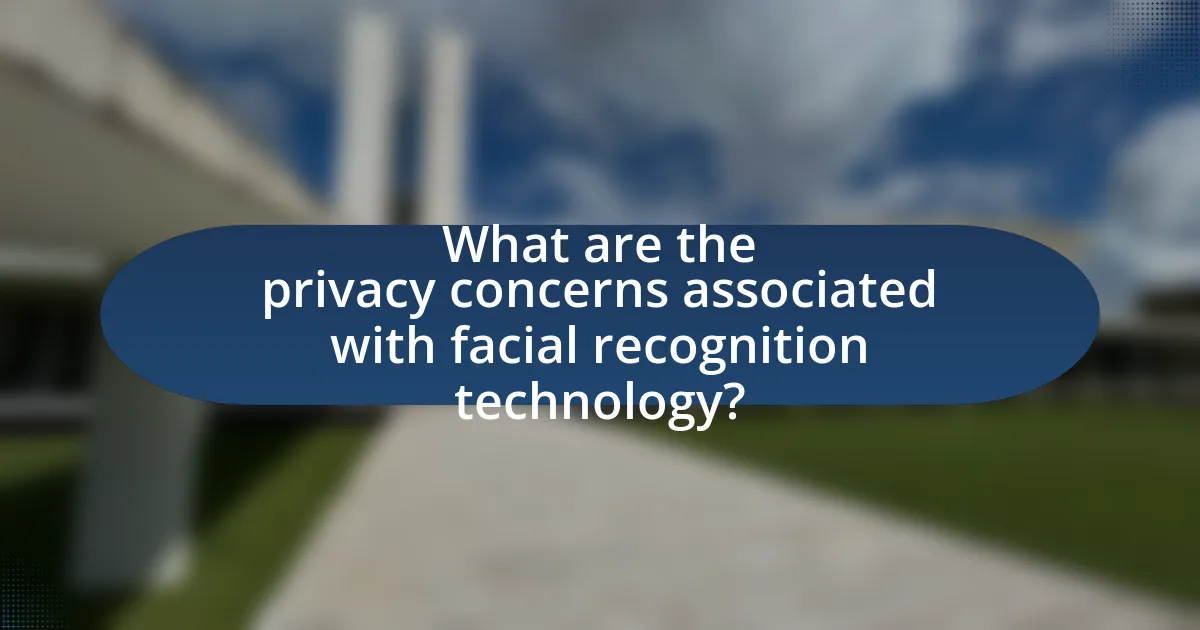
What are the privacy concerns associated with facial recognition technology?
Facial recognition technology raises significant privacy concerns, primarily due to its potential for mass surveillance and unauthorized data collection. This technology can track individuals without their consent, leading to a loss of anonymity in public spaces. Studies indicate that over 70% of Americans express concern about being monitored by facial recognition systems, highlighting widespread apprehension regarding personal privacy. Furthermore, the risk of data breaches and misuse of biometric data poses additional threats, as sensitive information can be exploited for identity theft or unauthorized profiling. These factors collectively underscore the urgent need for regulatory frameworks to protect individual privacy rights in the face of advancing facial recognition technology.
How does facial recognition technology infringe on personal privacy?
Facial recognition technology infringes on personal privacy by enabling the unauthorized collection and analysis of individuals’ biometric data without their consent. This technology allows for the tracking and identification of people in public spaces, often without their knowledge, leading to a significant erosion of anonymity. Studies indicate that over 70% of Americans express concern about the potential misuse of facial recognition by law enforcement and private companies, highlighting widespread apprehension regarding surveillance and data security. Furthermore, incidents of misidentification can lead to wrongful accusations and discrimination, further exacerbating privacy violations.
What are the risks of unauthorized data collection?
Unauthorized data collection poses significant risks, including privacy violations, identity theft, and misuse of personal information. These risks arise when individuals’ data is collected without consent, leading to potential exploitation by malicious actors. For instance, a report by the Electronic Frontier Foundation highlights that unauthorized data collection can facilitate targeted harassment and discrimination, as sensitive information may be used against individuals in harmful ways. Additionally, unauthorized data collection can undermine trust in technology and institutions, as people become wary of how their information is being used and shared.
How does surveillance impact individual privacy rights?
Surveillance significantly undermines individual privacy rights by enabling the continuous monitoring and collection of personal data without consent. This intrusion can lead to a chilling effect on free expression and behavior, as individuals may alter their actions knowing they are being watched. For instance, a study by the Electronic Frontier Foundation highlights that pervasive surveillance can result in self-censorship, where individuals refrain from participating in public discourse due to fear of being tracked or judged. Furthermore, the use of facial recognition technology in surveillance systems raises concerns about data security and misuse, as evidenced by incidents where personal information has been compromised or exploited. Thus, surveillance practices directly threaten the fundamental right to privacy by eroding the boundaries of personal space and autonomy.
What legal frameworks exist to protect personal privacy in relation to facial recognition?
Legal frameworks that protect personal privacy in relation to facial recognition include the General Data Protection Regulation (GDPR) in the European Union, which mandates explicit consent for data processing and grants individuals rights over their personal data. Additionally, the California Consumer Privacy Act (CCPA) provides California residents with rights regarding their personal information, including the right to know what data is collected and the right to opt-out of its sale. Furthermore, various states in the U.S. have enacted specific laws regulating the use of facial recognition technology by law enforcement, such as Illinois’ Biometric Information Privacy Act (BIPA), which requires informed consent before collecting biometric data. These frameworks collectively aim to safeguard individual privacy rights against the potential misuse of facial recognition technology.
What are the current laws governing facial recognition technology?
Current laws governing facial recognition technology vary by jurisdiction but generally focus on privacy, data protection, and civil liberties. In the United States, several states, including California and Illinois, have enacted laws that regulate the use of facial recognition, requiring transparency and consent for data collection. For instance, Illinois’ Biometric Information Privacy Act mandates that companies obtain informed consent before collecting biometric data, including facial recognition data. Additionally, cities like San Francisco and Boston have implemented bans on the use of facial recognition by city agencies, citing concerns over privacy and potential misuse. In the European Union, the General Data Protection Regulation (GDPR) imposes strict guidelines on the processing of personal data, which includes facial recognition technology, emphasizing the need for explicit consent and the right to data access. These laws reflect a growing recognition of the need to balance technological advancements with individual privacy rights.
How do different countries approach facial recognition regulations?
Different countries approach facial recognition regulations with varying degrees of restriction and oversight. For instance, the European Union has proposed strict regulations under the General Data Protection Regulation (GDPR), which emphasizes data protection and privacy rights, limiting the use of facial recognition in public spaces. In contrast, the United States lacks a federal law specifically governing facial recognition, leading to a patchwork of state-level regulations, with some states like California implementing laws that require transparency and accountability from companies using the technology. Meanwhile, China employs facial recognition extensively for surveillance purposes, with minimal regulations, prioritizing security over privacy concerns. These diverse approaches reflect differing cultural attitudes towards privacy and security, influencing how facial recognition technology is integrated into society.
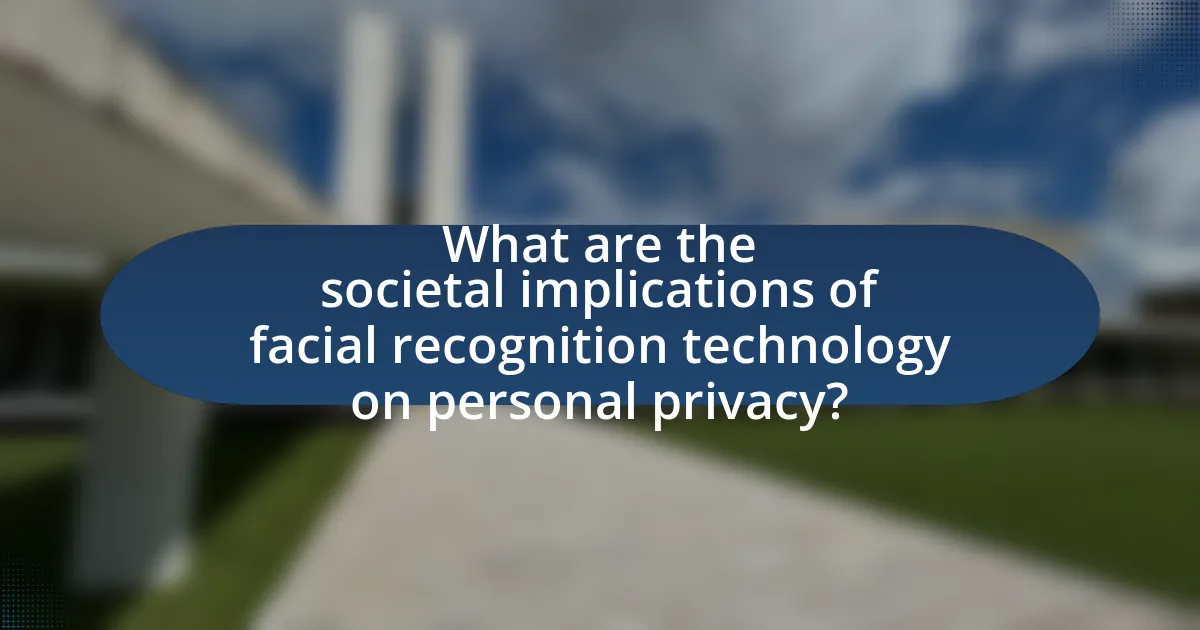
What are the societal implications of facial recognition technology on personal privacy?
Facial recognition technology significantly undermines personal privacy by enabling mass surveillance and data collection without individuals’ consent. This technology allows governments and corporations to track individuals’ movements and behaviors in public spaces, leading to a chilling effect on free expression and assembly. For instance, a study by the American Civil Liberties Union (ACLU) found that law enforcement agencies across the United States have increasingly adopted facial recognition systems, raising concerns about potential misuse and discrimination. Furthermore, a report from the European Union Agency for Fundamental Rights highlights that such surveillance can disproportionately affect marginalized communities, exacerbating existing societal inequalities. These implications indicate that while facial recognition technology can enhance security, it poses serious risks to individual privacy rights and civil liberties.
How does public perception influence the use of facial recognition technology?
Public perception significantly influences the use of facial recognition technology by shaping regulatory policies and adoption rates. When the public expresses concerns about privacy violations and potential misuse, governments and organizations often respond by implementing stricter regulations or limiting the deployment of such technology. For instance, a 2020 survey by the Pew Research Center found that 79% of Americans expressed concern about how facial recognition technology could be used by law enforcement, leading several cities to ban its use. This demonstrates that widespread public apprehension can directly impact the operational landscape of facial recognition technology, prompting stakeholders to reconsider its implementation in various contexts.
What are the common misconceptions about facial recognition technology?
Common misconceptions about facial recognition technology include the belief that it is infallible, that it can identify individuals in any condition, and that it operates without privacy concerns. Many people assume that facial recognition systems are 100% accurate; however, studies, such as those conducted by the National Institute of Standards and Technology (NIST), have shown that accuracy can vary significantly based on factors like lighting, angle, and demographic differences. Additionally, some believe that facial recognition can work effectively in all environments, but real-world applications often face challenges such as occlusions or poor image quality. Lastly, there is a misconception that facial recognition technology does not raise privacy issues; in reality, its deployment can lead to surveillance concerns and potential misuse, as highlighted by various privacy advocacy groups.
How do societal attitudes shape privacy policies?
Societal attitudes significantly shape privacy policies by influencing public demand for data protection and the regulatory responses of governments. For instance, as public concern over surveillance and data misuse increases, policymakers are more likely to implement stringent privacy regulations, such as the General Data Protection Regulation (GDPR) in the European Union, which was largely driven by growing societal awareness of privacy issues. Additionally, surveys indicate that a majority of individuals express discomfort with facial recognition technology, prompting lawmakers to consider restrictions or guidelines that reflect these societal sentiments. This dynamic illustrates how collective attitudes can lead to the establishment of privacy frameworks that prioritize individual rights and data security.
What measures can individuals take to protect their privacy from facial recognition technology?
Individuals can protect their privacy from facial recognition technology by using methods such as wearing masks or face coverings, utilizing privacy-focused apps, and opting for devices with privacy settings. Wearing masks or face coverings can obscure facial features, making it difficult for recognition systems to identify individuals. Privacy-focused apps can help manage and limit the data shared with companies that utilize facial recognition. Additionally, individuals can adjust privacy settings on their devices to restrict access to their images and personal information. These measures are supported by studies indicating that facial recognition systems rely heavily on clear facial data, which can be mitigated through these protective actions.
What are effective strategies for minimizing facial recognition exposure?
Effective strategies for minimizing facial recognition exposure include using physical barriers, altering appearance, and employing technology to obscure facial features. Physical barriers, such as wearing masks or sunglasses, can significantly hinder facial recognition systems, which rely on clear facial visibility. Altering appearance through changes in hairstyle, makeup, or clothing can also disrupt recognition algorithms, as these systems often depend on consistent visual data. Additionally, utilizing technology like anti-surveillance clothing or facial recognition-blocking apps can further protect individuals from being identified by these systems. Research indicates that these methods can reduce the accuracy of facial recognition technologies, thereby enhancing personal privacy.
How can individuals advocate for stronger privacy protections?
Individuals can advocate for stronger privacy protections by actively participating in public discourse, supporting legislation, and engaging with organizations focused on privacy rights. Advocacy efforts can include contacting lawmakers to express concerns about facial recognition technology and its implications for personal privacy, as well as promoting awareness through social media campaigns. Research indicates that public pressure can influence policy changes; for instance, a 2020 study by the Electronic Frontier Foundation found that grassroots movements have successfully led to the introduction of privacy-related bills in various states. By mobilizing community support and leveraging existing platforms, individuals can effectively push for enhanced privacy regulations.
What are the future trends in facial recognition technology and personal privacy?
Future trends in facial recognition technology indicate an increasing integration of artificial intelligence and machine learning, enhancing accuracy and efficiency in identification processes. As these technologies evolve, concerns regarding personal privacy will intensify, leading to stricter regulations and public scrutiny. For instance, the implementation of laws like the General Data Protection Regulation (GDPR) in Europe reflects a growing demand for transparency and consent in data usage. Additionally, advancements in privacy-preserving techniques, such as federated learning, aim to mitigate risks by allowing models to learn from decentralized data without compromising individual privacy. These trends suggest a dual trajectory where technological advancements must balance innovation with ethical considerations surrounding personal privacy.
How might advancements in technology affect privacy concerns?
Advancements in technology significantly heighten privacy concerns by enabling more pervasive surveillance and data collection. For instance, facial recognition technology allows for the identification and tracking of individuals in public spaces without their consent, raising ethical and legal questions about personal privacy. A study by the American Civil Liberties Union found that facial recognition systems misidentified people of color at rates up to 34%, highlighting the potential for discriminatory practices and misuse of personal data. As technology evolves, the capacity for intrusive monitoring increases, leading to a greater risk of privacy violations and the erosion of individual autonomy.
What role will public policy play in shaping the future of facial recognition?
Public policy will play a critical role in shaping the future of facial recognition by establishing regulations that govern its use, ensuring accountability, and protecting individual privacy rights. As governments increasingly recognize the implications of facial recognition technology on civil liberties, they are likely to implement laws that limit its application in public spaces and require transparency from organizations that utilize this technology. For instance, jurisdictions like San Francisco and Boston have already enacted bans on facial recognition for city use, reflecting a growing trend towards regulatory frameworks aimed at safeguarding personal privacy. These policies will influence how facial recognition is developed, deployed, and monitored, ultimately determining the balance between technological advancement and the protection of individual rights.
